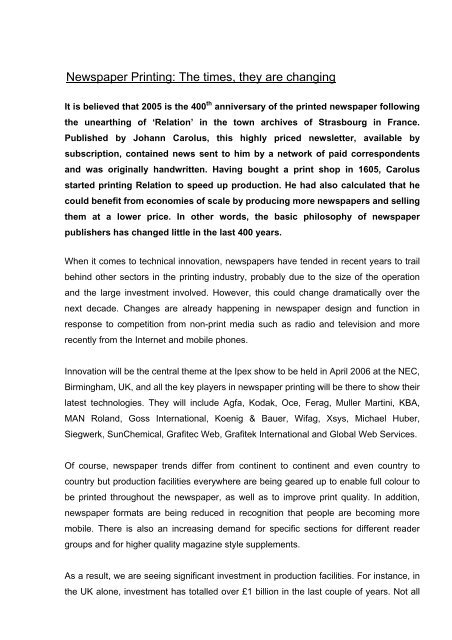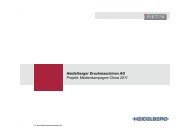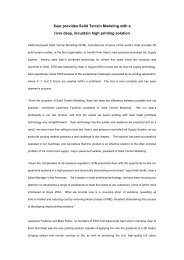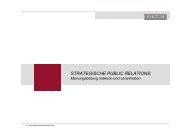Newspaper Printing: The times, they are changing - Faktum
Newspaper Printing: The times, they are changing - Faktum
Newspaper Printing: The times, they are changing - Faktum
You also want an ePaper? Increase the reach of your titles
YUMPU automatically turns print PDFs into web optimized ePapers that Google loves.
<strong>Newspaper</strong> <strong>Printing</strong>: <strong>The</strong> <strong>times</strong>, <strong>they</strong> <strong>are</strong> <strong>changing</strong><br />
It is believed that 2005 is the 400 th anniversary of the printed newspaper following<br />
the unearthing of ‘Relation’ in the town archives of Strasbourg in France.<br />
Published by Johann Carolus, this highly priced newsletter, available by<br />
subscription, contained news sent to him by a network of paid correspondents<br />
and was originally handwritten. Having bought a print shop in 1605, Carolus<br />
started printing Relation to speed up production. He had also calculated that he<br />
could benefit from economies of scale by producing more newspapers and selling<br />
them at a lower price. In other words, the basic philosophy of newspaper<br />
publishers has changed little in the last 400 years.<br />
When it comes to technical innovation, newspapers have tended in recent years to trail<br />
behind other sectors in the printing industry, probably due to the size of the operation<br />
and the large investment involved. However, this could change dramatically over the<br />
next decade. Changes <strong>are</strong> already happening in newspaper design and function in<br />
response to competition from non-print media such as radio and television and more<br />
recently from the Internet and mobile phones.<br />
Innovation will be the central theme at the Ipex show to be held in April 2006 at the NEC,<br />
Birmingham, UK, and all the key players in newspaper printing will be there to show their<br />
latest technologies. <strong>The</strong>y will include Agfa, Kodak, Oce, Ferag, Muller Martini, KBA,<br />
MAN Roland, Goss International, Koenig & Bauer, Wifag, Xsys, Michael Huber,<br />
Siegwerk, SunChemical, Grafitec Web, Grafitek International and Global Web Services.<br />
Of course, newspaper trends differ from continent to continent and even country to<br />
country but production facilities everywhere <strong>are</strong> being ge<strong>are</strong>d up to enable full colour to<br />
be printed throughout the newspaper, as well as to improve print quality. In addition,<br />
newspaper formats <strong>are</strong> being reduced in recognition that people <strong>are</strong> becoming more<br />
mobile. <strong>The</strong>re is also an increasing demand for specific sections for different reader<br />
groups and for higher quality magazine style supplements.<br />
As a result, we <strong>are</strong> seeing significant investment in production facilities. For instance, in<br />
the UK alone, investment has totalled over £1 billion in the last couple of years. Not all
the investment is in offset printing. As well as expanding its KBA flexographic presses at<br />
Harmsworth Quays in London, Associated <strong>Newspaper</strong>s is also building a second £80<br />
million Greenfield site flexo plant to enable it to print full colour throughout its national<br />
newspapers.<br />
By the time this happens, it is also expected that a flexographic computer-to-plate<br />
system capable of output speeds suitable for newspaper production will also be<br />
commercially available: it is understood that MacDermid <strong>Printing</strong> Solutions will have an<br />
automated machine available early next year. However, the news that the majority of<br />
newspapers <strong>are</strong> waiting for is the launch of a processless offset plate suitable for<br />
newspaper production. Although such plates <strong>are</strong> already available for some other print<br />
sectors, it is known that Agfa, Kodak and Fuji <strong>are</strong> all working on products which will not<br />
only be able to cope with newsprint but will also provide the necessary long runs. <strong>The</strong>y<br />
will also have to be economically viable, again something which will not be easy to<br />
achieve.<br />
<strong>The</strong> world-wide newspaper industry is still going strong. According to the World<br />
Association of <strong>Newspaper</strong>s, more than a billion people a day around the world read a<br />
printed newspaper, a figure which has risen nearly five per cent in the last five years.<br />
Perhaps even more impressive, newspapers account for around 25 per cent of global<br />
print sales, putting it well ahead of magazines or books. In fact, globally, sales <strong>are</strong> up 2.1<br />
per cent taking them to a new daily high of 395 million, while the number of daily titles is<br />
up two per cent. <strong>The</strong> growth is not only being driven by gains in developing countries but<br />
there have also been increases in sales in many mature markets.<br />
Although there is increasing competition from other media, particularly electronic, both<br />
publishers and equipment manufacturers have realised this and <strong>are</strong> coming up with<br />
numerous innovative ideas. A number of these could in turn be applied to other sectors<br />
of the printing industry as will be seen at Ipex 2006. <strong>The</strong>re has, for example, been a<br />
complete rethink about newspaper press design. As a result, we have seen the<br />
introduction of the Flexible <strong>Printing</strong> System from Goss International, the Cortina press<br />
from Koenig & Bauer and the Evolution press from Wifag. Although each press is<br />
different, the fundamental thinking is that newspaper production in the future will have to<br />
change and presses being installed now will have to be able to meet new challenges.
For many newspapers it will be more viable to distribute and print rather than the<br />
traditional print and distribute concept. In addition, there will be an increasing demand for<br />
finer zoning of newspaper editions making runs that much shorter. <strong>The</strong> FPS and the<br />
Cortina, with their compact size and slide apart printing towers have been designed so<br />
that <strong>they</strong> can easily be installed in an existing building and require the minimum of press<br />
crews.<br />
Interestingly, the Cortina uses keyless waterless printing, again to improve ease of<br />
operation as well as print higher quality. Admittedly, it has taken some while to achieve<br />
this, the most difficult part being the development of suitable plates and inks. However,<br />
all the major manufacturers of conventional coldset inks including Xsys, Michael Huber,<br />
Siegwerk and SunChemical have been developing suitable products that <strong>are</strong> now being<br />
moved out of the laboratory into commercial production.<br />
<strong>The</strong> first Cortina (at Rodi Rotatiedruk in Holland) went into production early this year and<br />
KBA has orders for seven more presses. As <strong>they</strong> come on stream, it is expected that<br />
consumable costs will come down due to economy of scale, which could make waterless<br />
web-offset printing an interesting prospect for other sectors of the printing industry.<br />
Other developments include the ability to print coldset and heatset with the same inks<br />
and the use of ultraviolet drying, something which was previously not viable for<br />
newspaper production due to press speed limitations and the high costs involved. This<br />
will enable coldset presses to be used to print parts of the newspaper on glossy coated<br />
stock, thus giving the higher print quality and bright colours being demanded by<br />
advertisers and the later deadlines provided by newspaper production. It will also<br />
broaden newspaper printers’ existing capabilities and increase press utilisation.<br />
<strong>Newspaper</strong> press manufacturers involved in UV trials include Wifag which with its<br />
evolution series of presses is also working on computer-to-press technology, as is MAN<br />
Roland with its DICOweb press. This technology has been used by small sheet-fed<br />
printers for some years but not for large web-fed presses and again the newspaper<br />
industry is leading the way.
Digital printing is also a key development in newspaper production. Currently, it is mainly<br />
being used to enable people who <strong>are</strong> away from home to read their favourite newspaper<br />
on Day A rather than B or C. This is achieved by web-fed digital presses printing a few<br />
hundred copies in main cities around the world, as is possible with Oce’s Digital<br />
<strong>Newspaper</strong> Network, or sheet-fed printing one-off copies on-demand such as the<br />
services offered by <strong>Newspaper</strong>Direct and Satellite <strong>Newspaper</strong>s. Digital presses that<br />
can print in full colour on newsprint and at acceptable speeds <strong>are</strong> now becoming<br />
available. For example, Kodak Versamark is now offering an inkjet system that can print<br />
over 1,000 40-page colour newspapers an hour and other companies <strong>are</strong> expected to<br />
launch machines with similar or higher capabilities at Ipex 2006, if not before.<br />
With so many new technologies being developed for the newspaper industry it will be<br />
interesting to see what innovations will be highlighted at Ipex 2006. <strong>The</strong> philosophy of<br />
newspaper publishers may not have changed that much since Johann Carolus, but the<br />
technology <strong>they</strong> have access to, definitely has and will continue to do so over the next<br />
few years.<br />
- ends -





